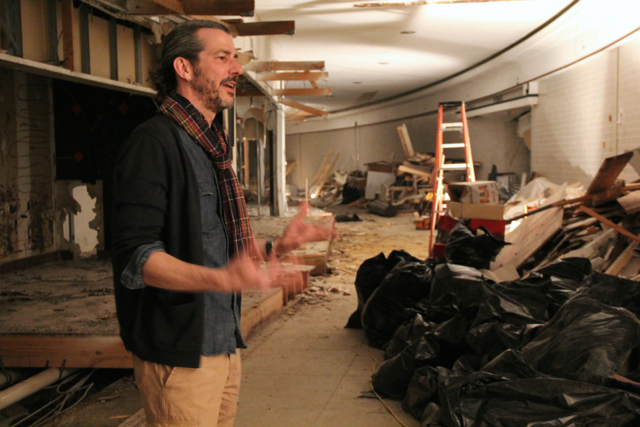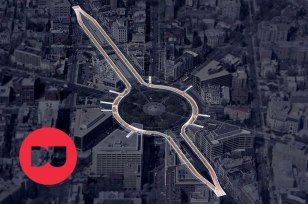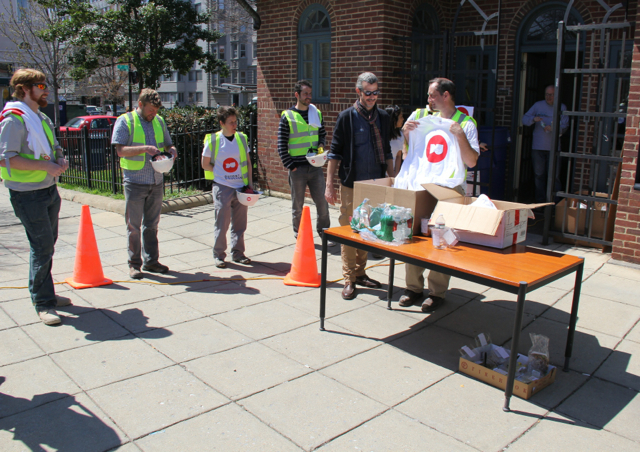DC Resident leads project to renovate the forgotten DuPont Underground
By McKinnon de Kuyper and Quincey Tickner

Braulio Agnese, wants to add one element to the District of Colombia: culture. Agnese is the managing director of the Dupont Underground, not the metro station, but the abandoned trolley station beneath Dupont Circle.
“We want to create a type of local cultural quality that doesn’t exist in Washington DC yet,” Braulio said. Braulio has been on the board of the Dupont Underground since its creation five years ago. Many may not know about it because the entrances are inconspicuous. The two entrances are made up of big sheets of rusted metal that open to an ominous and steep stairwell.
“In the next five years, we will clear the space out and open it up to different cultural things. From live music, to theatre, to art, to any type of pop up food shop,” Braulio said.

The curved tile covered walls give the appearance that the underground space goes on forever, however it only stretches from the northern to the southern end of Dupont Circle. To Braulio, the space does seem never ending because the aim is to redevelop all 75,000 square feet as a mixed-use cultural destination.
“None of this could have started without the amazing volunteers we have. Today, we have 25 volunteers working but so many people signed up,” Braulio said. Due to safety, Braulio could only utilize 25 volunteers but as the space develops, more and more people can help out.
“I hope it’s something that adds a little culture,” said Travis Valentine, a Living Social employee and DuPont Underground Volunteer. “I hate to say the word ‘whimsy,’ but you’re basically going underground and you’re re-emerging.”
Valentine learned about the project from a co-worker and donated to the crowdfunding campaign soon after. When he got the email to volunteer, he jumped at the opportunity to help out.
“I’m not from D.C., I think the majority of the people volunteering today aren’t from D.C., but we’re trying to put down more meaningful roots,” said Erik Lampmann, Alliance for Justice fellow and Dupont Underground volunteer.

“We’re getting into this thing where we want to participate more in the local stuff,” said Ann Ingle, a new D.C. resident and Dupont Underground volunteer. “I saw this online and just kept a close eye on it.”
Ingle and her fellow volunteers look forward to visiting the space when it is finished.
“Right now we see it as a hollow shell, and we’re taking out the framing, we’re taking out the facade,” said Lampmann. “And so there’s so much potential for an open shell. I think it could be a great space for art or for short cinema or for productions or I don’t know, I think you could have a party space down there.”
“That’d be pretty rad,” said Valentine.
Today, volunteers are tearing down the remains of the short-lived food court from the mid-1990s. The food court and a designated fallout shelter in the 1960s were the only occupants of the space since the shutdown of the streetcar system in 1963. The history is seen throughout the space. There are still facades of the trolley car inspired food shops, deli and bakery signs, huge gold letters, and even a magazine from 1997 that Valentine found.
Nonetheless, Braulio cant wait to tear down every part of it to create his vision. His vision is exactly what the city needs: “To establish a cultural destination in the nation’s capital that partners with emerging voices in contemporary arts and architecture; encourages public participation, education, and engagement; and leverages development of the Dupont Underground as a catalytic force for the city in the 21st century,” says the Dupont Underground website.
The space will bring culture to D.C. that the city doesn’t have and will be a home for small galleries and performances.
“People always associate the Smithsonian with Washington DC art; however, the Smithsonian doesn’t belong to the city or any of the local people,” Braulio said. “It’s a great museum, but it leaves a small amount of room for local culture and art to thrive.”
“DC has the reputation of being very austere, impersonal, conformist town and this is one of so many little pockets of awesome ingenuity and creativity that I think need to be lifted up a little bit more,” said Lampmann.
As of now, the space is raw and the team is still getting a feel and an understanding for it. At the end of June, it will be open for small events and private parties. The overall feel right now is excitement. Excitement to create a space for local culture and artists to thrive in a community as great as Dupont.
“Being in Dupont is the best part about this whole project,” said Braulio. “It doesn’t get much better than Dupont, there is so much culture and energy here that will add a lot to the space.”
You must be logged in to post a comment.